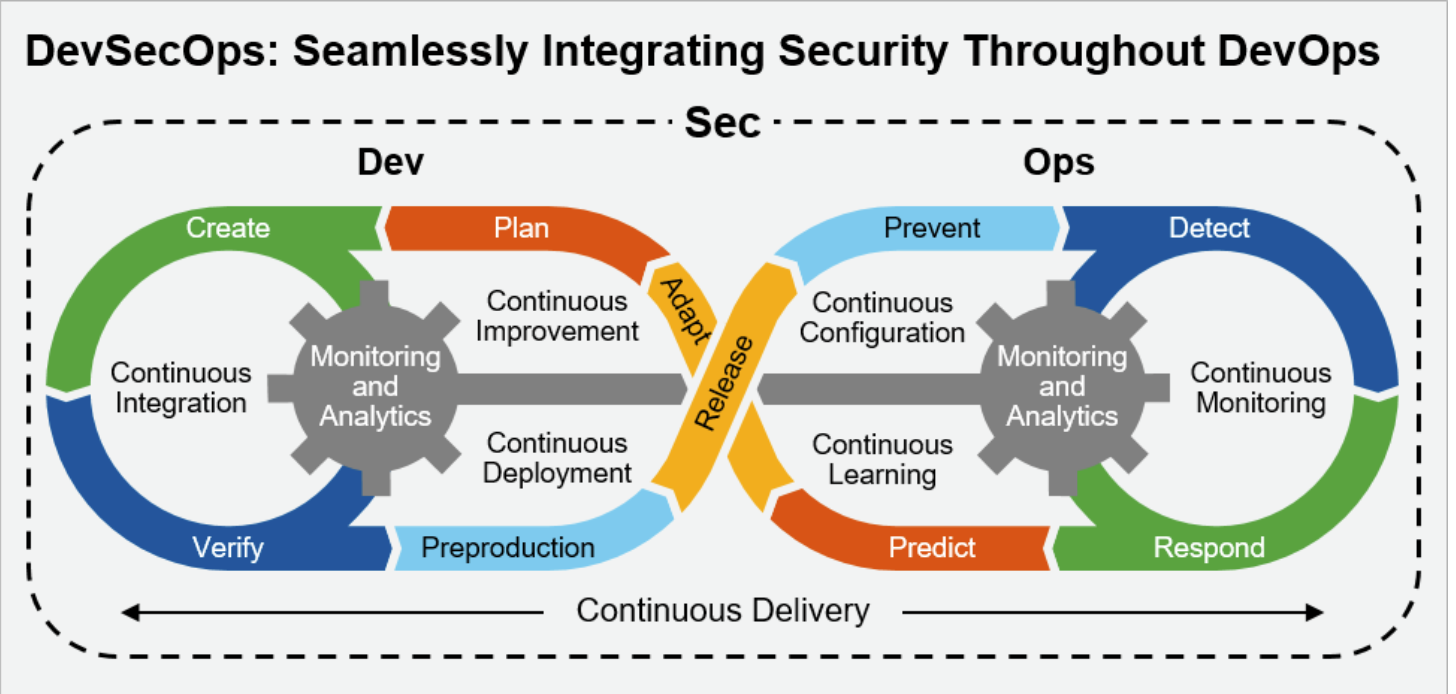What is DevSecOps? Benefits of Automated DevOps Security
DevSecOps is a methodology that integrates security as a shared responsibility throughout the entirety of the information technology lifecycle.
This methodology takes into account culture, automation, and platform architecture. The DevOps methodology, which emphasizes collaboration between software developers and IT operations, has evolved into this new approach.
In contrast to the traditional approach of adding security controls and considerations after the DevOps process, the DevSecOps methodology incorporates security concerns and controls from the very beginning of the process.
1.What is the major benefit of automated enablement in DevSecOps?
The biggest benefit of automated DevSecOps enabling is improved software development lifecycle security. Automation in DevSecOps facilitates continuous and early security practice integration, eliminating late-stage vulnerabilities and costly post-deployment corrections.
This improves software security and streamlines the development process, incorporating security checks and compliance without slowing down DevOps.
Automating security processes helps firms notice and fix security vulnerabilities faster, creating a proactive security culture that matches modern software development.
2.What is a main objective of security in DevSecOps?
Security in DevSecOps aims to seamlessly integrate security practices into the process, making security a basic and continuous element of software development and deployment.
Instead of putting security last, this integration identifies and mitigates threats early and consistently. DevSecOps aims to unify development, operations, and security teams by creating a culture and environment where building, testing, and deploying software can happen quickly, often, and safely.
This strategy improves application security, decreases security incidents, and encourages proactive security.
3. What are the three goals of security in DevSecOps?
The three primary goals of security in DevSecOps are:
- Early and Continuous Integration of Security
- Collaboration and Shared Responsibility
- Automation of Security Processes
What is DevSecOps?
A term coined from the three words “development,” “security,” and “ops,” “DevSecOps” refers to a way of thinking and doing software development that makes security an integral part of every step of the process.
By incorporating an early emphasis on security, this approach builds upon the ideas of DevOps, which promote cooperation and integration between IT operations teams and software developers.
DevOps is much more than just the functional operations and development teams.
To get the most out of the responsiveness and added agility of the DevOps approach, teams must also integrate IT security throughout the lifecycle of the application.
Why is this important?
In the recent past, security tended to be isolated to just one specific team that was active at the final stages of the app development. During this time, the delegation of security teams at the end of the process was less of an issue, since the cycles of development lasted much longer.
However, those days are now long gone. Modern enterprises use effective DevOps to ensure more frequent and rapid development cycles. Antiquated or outdated security measures can serve to derail even the utmost influential DevOps initiatives.
DevSecOps requires thinking about the security of the application and the infrastructure from the very start of the project. It can also require that some types of security gates be automated to prevent the workflow of the DevOps from experiencing slowdowns. Using the appropriate tools to integrate security continuously is crucial. Such tools as an integrated development environment (IDE), complete with cutting-edge security features, can assist in doing just that.
However, any truly effective DevOps integration takes much more than just modern tools. It also requires that the organization initiate cultural changes in terms of DevOps integration to ensure that the work done by security teams is finished promptly.
Built-in DevOps Security

Whether your enterprise refers to it as “DevOps” or “DevSecOps,” it is always a great idea to make security an essential portion of the life cycle of the app.
When using DevSecOps, it is essential to focus on built-in security, rather than security that essentially acts as a perimeter around the app.
If security is not focused on until the later portion of the development pipeline, the organizations that are adopting DevOps will find that they must go back to the involved development cycles they were trying to stay away from in the beginning.
It is crucial to move the focus of security further up the development pipeline to avoid running into these issues.
In some ways, DevSecOps serves to highlight the need to include security teams from the very outset of the project. These teams should be focusing on information security and how to make a plan to automate this security.
DevSecOps also highlights the need for developers and coders to create with security at the forefront. These teams must focus on maintaining feedback, visibility, and insights into any known security threats.
This type of integration can also include new security training for any developers that are involved. This training should be considered if the team includes any developers who predate the newer concepts of application development.
What does built-in security for DevSecOps look like? To start with, a decent DevSecOps strategy should be focused on conducting a risk and benefit analysis, as well as a tolerance review.
The goal should also be to determine the number of security controls that are necessary within any given application. The tests should also determine how important it will be to make it to the market quickly.
The automation of such tasks is one of the critical functions of DevSecOps. Running these tests and checks manually can be very time-consuming and use a lot of valuable resources.
Automated DevOps Security
One of the most extensive tasks involving DevOps security is the maintenance of frequent and short development cycles. These cycles should focus on minimal disruptions, as well as keeping up with emerging technology such as microservices and containers.
The DevOps should also focus on fostering close collaboration with teams that are commonly isolated from each other. This can be one of the most challenging implementations for any organization since all of these operations involve some human element.
The most significant way to facilitate all of these necessary human changes is to implement a framework that is focused on automation.
How can you decide which teams or tasks to automate and how? There are many ways to arrive at these conclusions. However, many organizations choose to take a step back and consider the development process as a whole and how it affects the operational environment.
These decisions also involve the container registries, the continuous integration pipeline, control repositories, API management, release automation, and operational monitoring.
The good news is that there are advancements in automation technologies all of the time. These technologies have helped many organizations shift into a more agile development environment, and have also played a significant role in the upgraded security measures DevOps has brought about.
Automation is exciting and useful, but it is not the only IT element that has been developed in recent years. Techs such as cloud-native containers and microservices are now crucial in most DevOps and DevSecOps initiatives. For this reason, organizations must adapt their security to keep up with these advances.
The larger scale and increasingly dynamic infrastructure that is enabled by container technology have evolved the way that many industries and organizations conduct their business.
Because of these advancements, DevOps practices must also advance and adapt to the new tech and align themselves with coinciding with container-specific security practices.
In general, cloud-native technologies adapt to static security checklists or policies very well. In fact, in most cases, security assets must be integrated continuously and checked at each level of the infrastructure and development life cycle.
In addition, DevSecOps means that security must be built-in and integrated from both ends of the development pipeline. This inclusive integration into the pipeline means that there must be a new organizational restructuring as well. This mindset should be ready to adapt and integrate the latest security tools.
Many DevSecOps teams choose to automate security tasks to protect the data and the overall environment. These teams also choose to automate the never-ending integration and delivery process through the pipeline.
This far-reaching goal of DevSecOps should also include the security of all microservices in the containers.
As technology advances, it is more important now than ever before for DevOps and DevSecOps teams to be adaptable to the latest tools available to them. Integration on both ends of the pipeline means your teams will have more resources to focus on high-priority tasks and issues.






